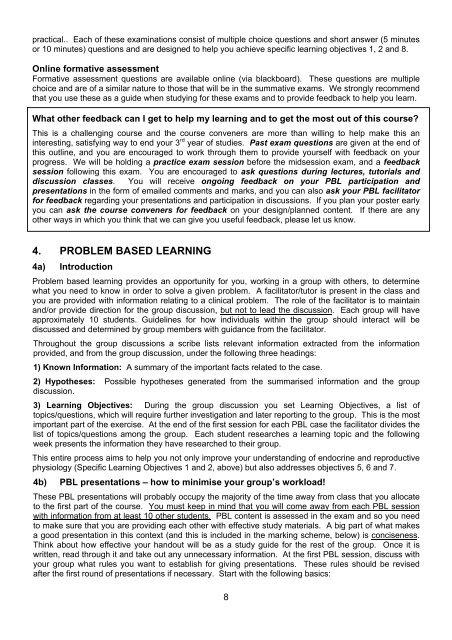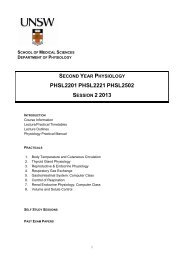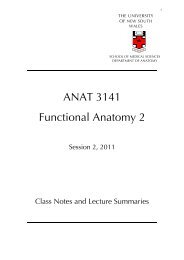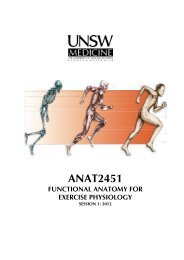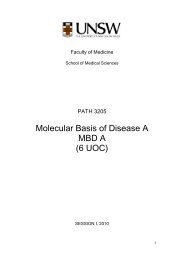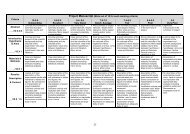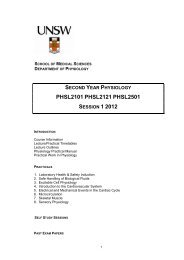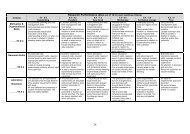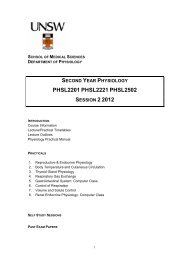endocrine, reproductive and developmental physiology - School of ...
endocrine, reproductive and developmental physiology - School of ...
endocrine, reproductive and developmental physiology - School of ...
Create successful ePaper yourself
Turn your PDF publications into a flip-book with our unique Google optimized e-Paper software.
practical.. Each <strong>of</strong> these examinations consist <strong>of</strong> multiple choice questions <strong>and</strong> short answer (5 minutes<br />
or 10 minutes) questions <strong>and</strong> are designed to help you achieve specific learning objectives 1, 2 <strong>and</strong> 8.<br />
Online formative assessment<br />
Formative assessment questions are available online (via blackboard). These questions are multiple<br />
choice <strong>and</strong> are <strong>of</strong> a similar nature to those that will be in the summative exams. We strongly recommend<br />
that you use these as a guide when studying for these exams <strong>and</strong> to provide feedback to help you learn.<br />
What other feedback can I get to help my learning <strong>and</strong> to get the most out <strong>of</strong> this course<br />
This is a challenging course <strong>and</strong> the course conveners are more than willing to help make this an<br />
interesting, satisfying way to end your 3 rd year <strong>of</strong> studies. Past exam questions are given at the end <strong>of</strong><br />
this outline, <strong>and</strong> you are encouraged to work through them to provide yourself with feedback on your<br />
progress. We will be holding a practice exam session before the midsession exam, <strong>and</strong> a feedback<br />
session following this exam. You are encouraged to ask questions during lectures, tutorials <strong>and</strong><br />
discussion classes. You will receive ongoing feedback on your PBL participation <strong>and</strong><br />
presentations in the form <strong>of</strong> emailed comments <strong>and</strong> marks, <strong>and</strong> you can also ask your PBL facilitator<br />
for feedback regarding your presentations <strong>and</strong> participation in discussions. If you plan your poster early<br />
you can ask the course conveners for feedback on your design/planned content. If there are any<br />
other ways in which you think that we can give you useful feedback, please let us know.<br />
4. PROBLEM BASED LEARNING<br />
4a) Introduction<br />
Problem based learning provides an opportunity for you, working in a group with others, to determine<br />
what you need to know in order to solve a given problem. A facilitator/tutor is present in the class <strong>and</strong><br />
you are provided with information relating to a clinical problem. The role <strong>of</strong> the facilitator is to maintain<br />
<strong>and</strong>/or provide direction for the group discussion, but not to lead the discussion. Each group will have<br />
approximately 10 students. Guidelines for how individuals within the group should interact will be<br />
discussed <strong>and</strong> determined by group members with guidance from the facilitator.<br />
Throughout the group discussions a scribe lists relevant information extracted from the information<br />
provided, <strong>and</strong> from the group discussion, under the following three headings:<br />
1) Known Information: A summary <strong>of</strong> the important facts related to the case.<br />
2) Hypotheses: Possible hypotheses generated from the summarised information <strong>and</strong> the group<br />
discussion.<br />
3) Learning Objectives: During the group discussion you set Learning Objectives, a list <strong>of</strong><br />
topics/questions, which will require further investigation <strong>and</strong> later reporting to the group. This is the most<br />
important part <strong>of</strong> the exercise. At the end <strong>of</strong> the first session for each PBL case the facilitator divides the<br />
list <strong>of</strong> topics/questions among the group. Each student researches a learning topic <strong>and</strong> the following<br />
week presents the information they have researched to their group.<br />
This entire process aims to help you not only improve your underst<strong>and</strong>ing <strong>of</strong> <strong>endocrine</strong> <strong>and</strong> <strong>reproductive</strong><br />
<strong>physiology</strong> (Specific Learning Objectives 1 <strong>and</strong> 2, above) but also addresses objectives 5, 6 <strong>and</strong> 7.<br />
4b) PBL presentations – how to minimise your group’s workload!<br />
These PBL presentations will probably occupy the majority <strong>of</strong> the time away from class that you allocate<br />
to the first part <strong>of</strong> the course. You must keep in mind that you will come away from each PBL session<br />
with information from at least 10 other students. PBL content is assessed in the exam <strong>and</strong> so you need<br />
to make sure that you are providing each other with effective study materials. A big part <strong>of</strong> what makes<br />
a good presentation in this context (<strong>and</strong> this is included in the marking scheme, below) is conciseness.<br />
Think about how effective your h<strong>and</strong>out will be as a study guide for the rest <strong>of</strong> the group. Once it is<br />
written, read through it <strong>and</strong> take out any unnecessary information. At the first PBL session, discuss with<br />
your group what rules you want to establish for giving presentations. These rules should be revised<br />
after the first round <strong>of</strong> presentations if necessary. Start with the following basics:<br />
8


